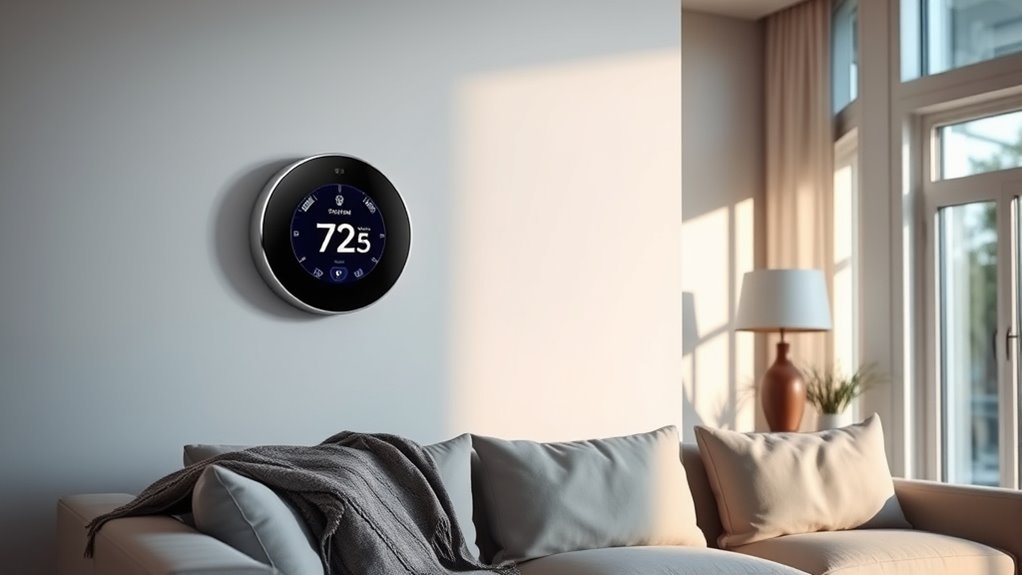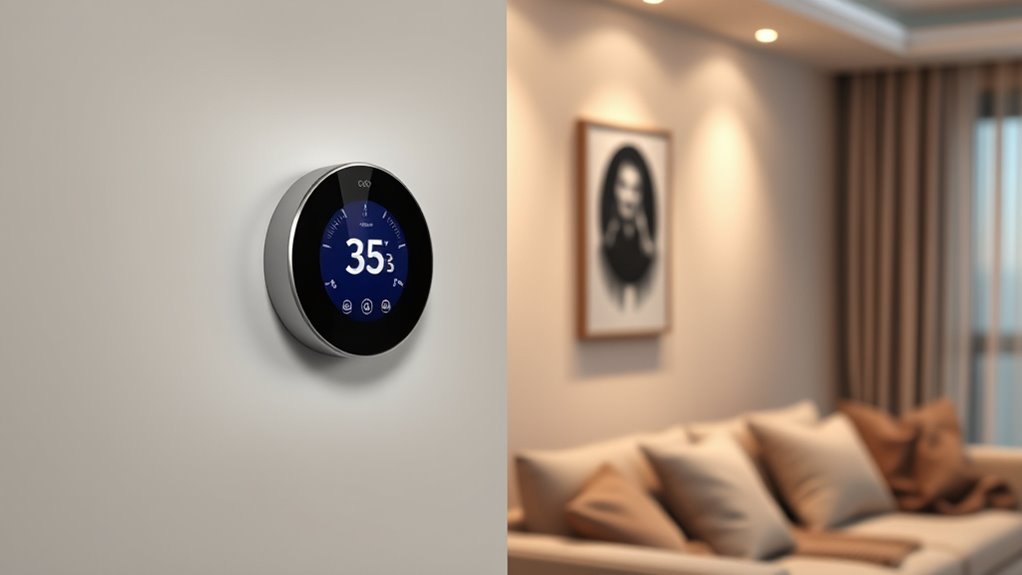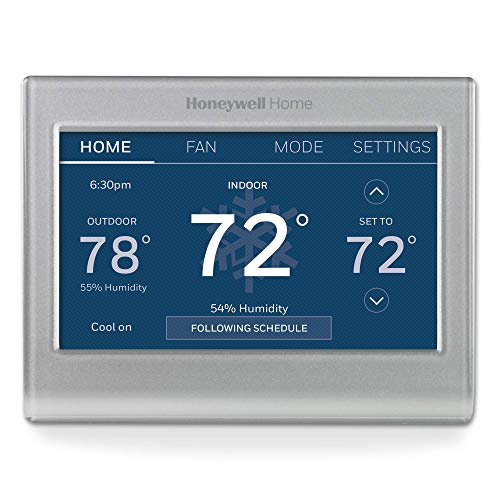If you’re looking to upgrade your home’s comfort and save energy in 2025, I recommend checking out the top smart thermostats like the ecobee Smart Thermostat Premium, Honeywell Color, and the Amazon Smart Thermostat. They offer easy installation, voice control, and environmental monitoring features that keep your home cozy while cutting costs. Want to find the best fit for your system? Keep exploring as I share more details on these and other top picks.
Key Takeaways
- Discover top-rated smart thermostats in 2025 that enhance comfort, convenience, and energy efficiency for various home HVAC systems.
- Learn about compatibility, installation, and user-friendly features for seamless setup and control.
- Explore advanced environmental monitoring and smart automation options to optimize home climate and air quality.
- Find models offering significant energy savings and cost benefits with features like auto-scheduling and occupancy sensing.
- Compare pros and cons of popular thermostats to select the best fit for your home’s needs and budget in 2025.
Amazon Smart Thermostat
If you’re looking for an affordable yet reliable smart thermostat that integrates seamlessly with Alexa, the Amazon Smart Thermostat is an excellent choice. Released in 2021, it works with most 24V HVAC systems, including heat pumps and radiant boilers, but not 110-240V systems. It supports sensors via Echo devices and the Amazon Smart Air Quality Monitor, helping manage hot and cold spots. Easy to install with a C-wire or power adapter, setup takes about 30-60 minutes. Its sleek design, on-device controls, and app-based scheduling make it user-friendly. Plus, energy-saving features and rebates make it a cost-effective upgrade for your smart home.
Best For: homeowners seeking an affordable, easy-to-install smart thermostat that integrates seamlessly with Alexa and offers energy-saving features for most 24V HVAC systems.
Pros:
- Compatible with a wide range of 24V HVAC systems, including heat pumps and radiant boilers
- User-friendly setup with app-based scheduling and on-device control buttons
- Supports sensors for hot/cold spot management and energy monitoring features
Cons:
- Limited to 2.4 GHz Wi-Fi, which may affect connectivity in some homes
- Basic scheduling allows only four fixed temperature profiles, with some reported issues after power outages
- Customer support experiences vary, with some users citing difficulties with outsourced assistance
ecobee Smart Thermostat Premium with Sensors and Air Quality Monitor
The ecobee Smart Thermostat Premium stands out for homeowners seeking all-encompassing control and energy savings, thanks to its advanced sensors and air quality monitoring features. It can reduce heating and cooling costs by up to 26% annually and includes a SmartSensor valued at $50 for precise room temperature management. The built-in air quality monitor alerts you to poor air conditions and suggests improvements, while the thermostat’s compatibility with major smart home platforms makes voice control effortless. Its sleek LCD display, occupancy sensing, and safety features like smoke detection elevate its appeal. Installation can be complex, but its extensive monitoring and energy-saving capabilities make it a top choice in smart thermostats.
Best For: homeowners seeking comprehensive energy savings, advanced environmental monitoring, and seamless smart home integration.
Pros:
- Significantly reduces energy costs by up to 26% annually with ENERGY STAR certification.
- Includes advanced sensors and air quality monitor for precise climate control and improved indoor air quality.
- Supports multiple smart home platforms like Siri, Alexa, Google Assistant, and IFTTT for versatile voice control and automation.
Cons:
- Installation can be complex, especially for older HVAC systems or homes without a C-wire.
- Setup and sensor configuration instructions may be confusing, sometimes requiring professional assistance.
- Customer support experiences vary, with some users reporting difficulty resolving technical issues or understanding integration steps.
ecobee3 Lite Smart Thermostat, Wi-Fi Programmable Thermostat
Designed for homeowners seeking easy installation and smart energy savings, the ecobee3 Lite Smart Thermostat stands out with its compatibility across most 24VAC HVAC systems and its user-friendly setup process. Its sleek, modern touchscreen makes programming simple, even for first-timers. The thermostat helps cut heating and cooling costs by up to 23% annually, thanks to occupancy detection and room sensors. Plus, it supports voice control with Siri, Alexa, and Google Assistant, seamlessly integrating with smart home ecosystems. Installation is straightforward, with detailed app guidance and optional PEK for homes without a C-wire. Overall, it’s a reliable, cost-effective option for smarter home climate control.
Best For: homeowners seeking easy DIY installation, smart energy savings, and seamless integration with popular voice assistants and smart home systems.
Pros:
- User-friendly touchscreen interface and quick setup process
- Compatible with most 24VAC HVAC systems, including heat pumps and boilers
- Helps reduce energy bills by up to 23% annually through occupancy detection and smart scheduling
Cons:
- Requires Wi-Fi connection for full functionality and remote control
- May need Power Extender Kit (PEK) or C-wire for certain installations without existing wiring
- Limited advanced customization features compared to higher-end models
Honeywell Home RTH9600WF Smart Color Thermostat
The Honeywell Home RTH9600WF Smart Color Thermostat stands out for its vibrant, customizable touchscreen display, making it an excellent choice for homeowners who want both functionality and style. Its high-definition color screen can be personalized to match your home décor or mood, displaying indoor and outdoor temperatures, humidity, and weather forecasts. Supporting flexible programming and auto-switching between heat and cool through Honeywell’s Smart Response technology, it learns your household cycles for ideal comfort. Compatible with various heating systems and Wi-Fi-enabled for remote control via smartphone app, it combines energy efficiency with intuitive operation and sleek design. Backup features include alerts, reminders, and multi-language support.
Best For: homeowners seeking a stylish, customizable, and energy-efficient smart thermostat with easy remote control and integration with popular smart home platforms.
Pros:
- Vibrant, high-definition color touchscreen display that can be personalized to match home décor or mood.
- Supports flexible programming, auto-switching between heat and cool, and learning household cycle times through Honeywell’s Smart Response technology.
- Compatible with a wide range of heating systems and offers remote management via smartphone app, integrating with Alexa, Google Assistant, and other platforms.
Cons:
- C-wire required for proper power, which may necessitate additional wiring or adapters in some homes.
- Some users report delicate wire connectors during installation, requiring careful handling.
- Humidity readings can vary slightly from external sensors, potentially affecting accuracy.
Amazon Smart Thermostat
If you’re looking for an affordable yet smart way to control your home’s temperature, the Amazon Smart Thermostat is a solid choice. Released in 2021, it’s compatible with most 24V HVAC systems, including force air, heat pumps, and radiant boilers, but not with 110-240V systems like electric baseboard heat. It supports sensors through Echo devices and Amazon’s Air Quality Monitor, helping manage hot and cold spots. Made with Honeywell technology, it’s ENERGY STAR certified, and integrates seamlessly with Alexa and Ring apps. Setup is straightforward via the app, and manual controls are available on the device itself, making it a budget-friendly, versatile upgrade.
Best For: budget-conscious homeowners seeking an easy-to-install, energy-efficient smart thermostat compatible with most 24V HVAC systems.
Pros:
- Affordable price point with potential rebates making it cost-effective
- Easy setup via the Alexa app with automated wiring guidance
- Supports multiple sensors and integrations for enhanced comfort and energy savings
Cons:
- Limited to 2.4 GHz Wi-Fi networks, which may affect connectivity in some homes
- Basic scheduling features with only four fixed temperature profiles, lacking advanced customization
- Occasional connectivity issues after power outages that may require resets or replacements
ecobee Smart Thermostat Essential (2025 Model)
For anyone seeking an energy-efficient smart thermostat that’s easy to install and compatible with popular voice assistants, the ecobee Smart Thermostat Essential (2025 model) is an excellent choice. It’s Energy Star certified, Wi-Fi enabled, and works with Siri, Alexa, Google Assistant, and Apple HomeKit. Its sleek, round LCD touch interface offers auto-scheduling, auto-away mode, fan control, and programmable settings. Designed for wall mounting, it suits various HVAC systems like electric baseboard heaters and air conditioners. Users love its quick setup—often under 30 minutes—and remote control via app. With proven energy savings of up to 23%, it’s a smart upgrade for comfort and cost savings.
Best For: homeowners seeking an easy-to-install, energy-efficient smart thermostat compatible with popular voice assistants and featuring a sleek design.
Pros:
- Simple installation process often completed within 30 minutes
- Energy savings of up to 23%, leading to cost reductions
- Compatible with Siri, Alexa, Google Assistant, and Apple HomeKit for seamless smart home integration
Cons:
- Supports only one schedule that must be manually adjusted each season
- Limited scheduling granularity with 30-minute intervals and no minute-level control
- Cannot communicate with other thermostats in multi-zone home setups
Honeywell Wi-Fi Smart Color Thermostat
When selecting a smart thermostat that combines style and functionality, the Honeywell Wi-Fi Smart Color Thermostat stands out with its customizable color options, allowing you to match your décor seamlessly. It offers a 7-day programmable schedule with flexible options for personal routines or utility peak rates. The bright, easy-to-read touchscreen makes operation simple and intuitive. Compatible with most forced air systems, it supports Wi-Fi control via your smartphone and works with voice assistants like Alexa. Certified ENERGY STAR, it helps track energy use, offers personalized tips, and supports utility programs for savings. Just confirm your system has a C-wire and check compatibility before installing.
Best For: homeowners seeking a customizable, energy-efficient smart thermostat that integrates seamlessly with their Wi-Fi and voice assistants.
Pros:
- Customizable color options to match home décor
- 7-day programmable schedule for personalized routines and utility peak rate management
- ENERGY STAR certified for energy savings and tracking
Cons:
- Requires a C-wire for installation; not compatible with electric baseboard heat
- Not suitable for homes without forced air heating systems
- Compatibility check needed before purchase to ensure system support
ecobee Smart Thermostat Enhanced, Programmable WiFi Thermostat
The ecobee Smart Thermostat Enhanced stands out as an excellent choice for homeowners seeking energy savings and seamless smart home integration. I appreciate its sleek LCD display and compatibility with popular platforms like Apple HomeKit, Alexa, Google Assistant, and SmartThings. Designed for furnace systems, it adjusts temperatures based on occupancy, helping cut energy costs. The remote control feature via app or voice makes managing my home easy from anywhere. Plus, it reports outside temperature and indoor humidity, offering valuable insights. Its straightforward setup, reliable connectivity, and 3-year warranty make it a top pick, despite some limitations like no native humidity control.
Best For: homeowners seeking an energy-efficient, easy-to-integrate smart thermostat compatible with various voice assistants and smart home platforms.
Pros:
- Seamless compatibility with Apple HomeKit, Alexa, Google Assistant, and SmartThings for versatile smart home integration
- User-friendly app control and remote access from anywhere for added convenience
- Reports on outside temperature and indoor humidity for comprehensive climate management
Cons:
- Lacks native humidity control, requiring additional sensors or solutions
- Some users find the standby display mode inconvenient as it switches off when not in use
- Subscription fees for certain smart sensors and occupancy features may add to overall costs
ecobee Smart Thermostat Premium with Sensor and Air Quality Monitor
The ecobee Smart Thermostat Premium with Sensor and Air Quality Monitor stands out as an ideal choice for homeowners who prioritize energy efficiency and all-encompassing home monitoring. It can cut heating and cooling costs by up to 26% annually and is ENERGY STAR certified. The device includes a SmartSensor valued at $50, which helps eliminate hot and cold spots, and a built-in air quality monitor that alerts you to poor air conditions. Supporting multiple smart home integrations like Siri, Alexa, and Google Assistant, it also acts as a safety hub with smoke detection and alerts. Its sleek LCD display and smart sensors make it a versatile, eco-friendly, and user-friendly upgrade.
Best For: homeowners seeking an energy-efficient, comprehensive smart thermostat with advanced sensors and air quality monitoring capabilities.
Pros:
- Reduces heating and cooling costs by up to 26% annually, saving money.
- Supports multiple smart home platforms including Siri, Alexa, and Google Assistant for seamless voice control.
- Includes built-in air quality monitoring and safety features like smoke detection for enhanced home health and security.
Cons:
- Installation can be complex, often requiring professional help or additional wiring.
- Sensor setup and integration instructions may be confusing or inconsistent.
- Support experiences vary, with some users finding technical assistance less familiar with complex configurations.
Sensi Smart Thermostat with Wi-Fi and Mobile App
If you’re looking for a smart thermostat that’s easy to install and offers robust energy-saving features, the Sensi Smart Thermostat with Wi-Fi and Mobile App is an excellent choice. With its sleek design, compatibility with most HVAC systems, and DIY-friendly setup, it’s perfect for homeowners. The mobile app makes programming, remote control, and monitoring simple, helping you save around 23% on energy bills. Voice control options through Alexa, Google Assistant, and others add convenience. Built-in alerts, maintenance reminders, and energy reports keep you informed. Plus, it’s Energy Star certified and made in the USA, ensuring reliable performance and efficiency.
Best For: homeowners seeking an easy-to-install, energy-efficient smart thermostat with remote management and voice control capabilities.
Pros:
- Easy DIY installation with step-by-step app guidance and wire labeling
- Significant energy savings of approximately 23%, reducing utility bills
- Compatible with major voice assistants like Alexa, Google Assistant, and more
Cons:
- Limited detailed usage data compared to some advanced thermostats
- Occasional connectivity delays reported by users
- Compatibility issues with certain voice assistants such as Bixby
T21 Programmable Thermostat for Home
Designed for homeowners seeking an easy, DIY-friendly thermostat, the T21 Programmable Thermostat for Home offers flexible compatibility with various heating and cooling systems, including single-stage units, heat pumps without auxiliary heat, and boilers. It supports gas, electric, and oil furnaces, and features dual power options—24VAC or 2 AA batteries—eliminating the need for a C-wire, though connecting one is recommended for stability. The thermostat has a straightforward wall-mount design, an LCD backlit display, and a 5+2 weekly schedule to help save energy. It’s simple to install, retains settings during outages, and includes a protective cover to prevent accidental adjustments.
Best For: homeowners seeking an easy-to-install, DIY-friendly thermostat compatible with a variety of heating and cooling systems to enhance energy efficiency and comfort.
Pros:
- Supports multiple system types including single-stage heating/cooling, heat pumps without auxiliary heat, boilers, and gas furnaces.
- Dual power options (24VAC or 2 AA batteries) eliminate the need for a C-wire, simplifying installation.
- User-friendly features like a backlit LCD display, 5+2 programmable schedule, and memory retention for power outages.
Cons:
- Not compatible with electric baseboard heat, line voltage systems, or mini-split systems.
- Requires support for 2-5 wires; incompatible with systems needing more or fewer wires.
- First available date listed as February 18, 2025, may be a future release or pre-order, potentially affecting immediate availability.
Thermostat for Heat Pump, Programmable Thermostat for Home
A programmable thermostat for home that supports heat pumps is an excellent choice for those seeking energy efficiency and customizable comfort. It works with multi-stage or single-stage heat pump systems, as well as forced air, electric furnaces, and other heat-only setups. Just be sure to verify compatibility, especially if you have complex wiring or dual fuel systems. With pre-set energy-saving schedules and flexible programming, it helps you stay comfortable while reducing energy bills. The user-friendly LCD display and straightforward installation make it accessible, though some wiring challenges may arise. Overall, it’s a reliable option once installed correctly, offering practical control for heat pump systems.
Best For: homeowners with heat pump, forced air, or heat-only systems seeking an energy-efficient, programmable thermostat with easy installation and customizable settings.
Pros:
- Supports a wide range of compatible heating systems including heat pumps and forced air units.
- Features pre-set energy-saving schedules and flexible programming for personalized comfort.
- User-friendly LCD display with backlight and straightforward installation process.
Cons:
- Wiring can be challenging, especially for basic or complex systems, which may require experienced installation.
- Some users report difficulty in setup and poor customer support.
- Compatibility is limited with multi-stage, dual fuel, or line voltage systems, so verification is necessary before purchase.
EMERSON Sensi Touch Wi-Fi Smart Thermostat
The Emerson Sensi Touch Wi-Fi Smart Thermostat stands out for its user-friendly touchscreen color display and seamless compatibility with major voice assistants like Alexa, Google Assistant, Apple HomeKit, and Samsung SmartThings. I appreciate its sleek design, backlit LCD, and easy wall-mount setup, which most users can complete in under 30 minutes. It offers programmable schedules, geofencing, and filter alerts to optimize energy use and indoor air quality. Plus, remote control via the mobile app makes managing your home’s temperature simple from anywhere. With its reliable Wi-Fi connection and smart features, it’s a practical, energy-saving choice for any modern home.
Best For: homeowners seeking an easy-to-install, energy-efficient smart thermostat with user-friendly controls and robust compatibility with popular voice assistants.
Pros:
- Intuitive touchscreen color display and simple installation process, often under 30 minutes
- Compatibility with Alexa, Google Assistant, Apple HomeKit, and Samsung SmartThings for seamless smart home integration
- Energy-saving features like programmable schedules, geofencing, and filter alerts to reduce utility costs
Cons:
- Requires a C-wire for proper operation, which may necessitate additional wiring for some setups
- Limited control over certain algorithms and customization options compared to more advanced thermostats
- Some users report that the screen can fade or become less visible at certain viewing angles
Honeywell Home RTH7600D 7-Day Programmable Touchscreen Thermostat
If you’re looking for an easy-to-use thermostat that offers reliable scheduling and energy savings, the Honeywell Home RTH7600D 7-Day Programmable Touchscreen Thermostat stands out. It features a large, backlit touchscreen that displays current temperature and set point simultaneously, making adjustments straightforward. With 7-day programming and four periods per day, you can customize your schedule to suit your routine. Its smart response technology learns your heating and cooling patterns for ideal comfort, while auto changeover switches seamlessly between modes. Easy to install and compatible with many HVAC systems, it’s a cost-effective choice that combines simplicity, reliability, and energy efficiency.
Best For: homeowners or DIY enthusiasts seeking an easy-to-use, reliable, and energy-efficient programmable thermostat for their heating and cooling systems.
Pros:
- Intuitive touchscreen interface with clear display of current and set temperatures
- 7-day customizable scheduling with four periods per day for tailored comfort
- Easy installation compatible with many HVAC systems, including multi-stage units
Cons:
- Lacks system activity icons like flame or snowflake indicators for quick system status recognition
- Some functions, such as setting the date, may only be accessible through setup codes, which can be less user-friendly
- Plastic housing has some flexibility, which may impact durability over time
Google Nest Learning Thermostat, 3rd Gen (2015)
For homeowners seeking a smart thermostat that combines sleek design with intelligent learning capabilities, the Google Nest Learning Thermostat 3rd Gen (2015) stands out. Its stainless steel finish adds a modern touch, while the Auto-Schedule feature learns your habits to automatically set temperatures, saving you time. You can check energy usage through the app and see when you’re saving energy with the Nest Leaf indicator. It also automatically adjusts when you’re away, preventing waste. Plus, you can control it remotely from anywhere using the Nest app, giving you convenience and control over your home’s climate at all times.
Best For: homeowners seeking a sleek, intelligent, and energy-efficient thermostat that learns their preferences and offers remote control convenience.
Pros:
- Learns user habits to automatically adjust temperature settings, saving time and energy
- Compatible with Alexa and controllable remotely via the Nest app
- Features a modern stainless steel design that complements contemporary home decor
Cons:
- Requires Wi-Fi connection for optimal functionality and remote access
- Compatibility check needed to ensure it works with all home HVAC systems
- May be more costly upfront compared to traditional thermostats
Factors to Consider When Choosing Smart Thermostats for Home

When selecting a smart thermostat, I consider how well it works with my existing HVAC system and how easy it is to install. I also look at the energy-saving features and whether it integrates smoothly with my smart home devices. Finally, I weigh the cost, including any rebates, to make sure I get the best value for my investment.
Compatibility With HVAC Systems
Choosing a smart thermostat that works seamlessly with your home’s HVAC system requires careful consideration of compatibility. First, verify that the thermostat supports your system type, whether it’s forced air, heat pump, or boiler. Check if it requires a specific voltage, usually 24V, and whether you need a C-wire or a power extender kit to guarantee reliable power. It’s also important to confirm that the device can control your heating and cooling modes, especially if you have multi-stage systems or radiant heating. Additionally, review your wiring configuration to prevent installation issues. Ultimately, ensure the thermostat is compatible with your preferred smart home ecosystem, like Alexa, Google Assistant, or Apple HomeKit, for smooth integration and voice control.
Installation Complexity Level
The installation process for smart thermostats can vary considerably depending on the model and your existing HVAC setup. Some models are straightforward, requiring only basic wiring, while others demand advanced electrical work or professional help. Many DIY-friendly thermostats come with step-by-step app guides, wire labels, and minimal tools, making setup easier. If your system supports a common C-wire, installation tends to be simpler; without it, you might need additional components like power extender kits. Compatibility with your existing wiring and system type—such as single-stage, multi-stage, or heat pump—also influences difficulty. Features like multi-zone control or advanced sensors can complicate installation further, often requiring professional assistance to guarantee everything functions correctly.
Energy-Saving Features Offered
Energy-saving features are essential factors to take into account because they can markedly reduce your home’s overall energy consumption and save you money. Many smart thermostats include auto-scheduling that learns your routines and adjusts temperatures to optimize efficiency. Geofencing is another useful feature, which uses your phone’s location to reduce heating or cooling when you’re away. Occupancy sensors detect whether a room is occupied and adjust settings accordingly, preventing energy waste in empty spaces. Monitoring tools like energy dashboards give you detailed insights into your HVAC use, helping you identify further savings. Plus, some models participate in utility demand response programs, offering rebates or incentives for reducing energy during peak periods. These features can substantially lower your energy bills while maintaining comfort.
Smart Home Integration Capabilities
Smart home integration capabilities substantially enhance the functionality of a thermostat by allowing it to work seamlessly with other devices and platforms. Compatibility with popular smart home systems like Alexa, Google Assistant, Apple HomeKit, and Samsung SmartThings makes voice control and automation straightforward. Supporting multiple integrations offers greater flexibility, letting the thermostat coordinate with various ecosystem devices, sensors, and security systems to optimize comfort and energy use. Keep in mind, some models require additional hubs or bridges, which can add setup complexity but expand compatibility. Firmware and app updates are critical, often enhancing or expanding integration options over time. Choosing a thermostat with robust, future-proof integration ensures your smart home remains cohesive, adaptable, and easy to control, making your home more efficient and responsive.
Cost and Rebate Options
Considering the cost and rebate options when choosing a smart thermostat can make a significant difference in your overall investment. Many models are eligible for utility rebates or incentives, which can cut costs or even make the thermostat free. The initial price varies widely—from budget-friendly options around $50 to premium models exceeding $250. Some retailers also offer discounts, bundle deals, or promotional codes that lower expenses. It’s important to verify rebate eligibility beforehand, as many programs require specific models or energy certifications. While upfront costs can vary, remember that smart thermostats can save you 10-26% on heating and cooling bills over time. This long-term savings can offset the initial investment, making smart thermostats a smart financial choice in the long run.
Frequently Asked Questions
How Do Smart Thermostats Impact Home Security and Data Privacy?
Smart thermostats can enhance home security by allowing remote control and monitoring, making it easier to detect unusual activity. However, they also collect data on your habits, which raises privacy concerns. I always make sure to use strong passwords and keep firmware updated. Staying aware of how my data is used helps me enjoy the benefits without compromising my security or privacy.
Can Smart Thermostats Be Integrated With Solar Power Systems?
Think of smart thermostats as the conductor of your home’s energy symphony. They can indeed be integrated with solar power systems, acting as the maestro to optimize energy use. I’ve found that many models now seamlessly connect with solar setups, adjusting their operations to maximize solar energy efficiency. This integration not only helps save on bills but also makes your home more eco-friendly—like giving your energy system a green thumbs-up!
What Maintenance Is Required for Optimal Smart Thermostat Performance?
To keep my smart thermostat running smoothly, I regularly clean the filters and vents to prevent dust buildup. I also check for software updates to make sure I have the latest features and security patches. Additionally, I verify the wiring connections and reset the device if it acts up. These simple steps help me maintain peak performance, save energy, and enjoy a cozy home year-round.
Are Smart Thermostats Compatible With All Types of Heating and Cooling Systems?
When wondering if smart thermostats work with your system, I always check compatibility first. Not all models suit every heating or cooling setup, especially older or specialized systems. I recommend reviewing your HVAC type and matching it with the thermostat’s specifications. Sometimes, I’ve needed an additional relay or adapter. Doing this guarantees I get the right smart thermostat that works seamlessly and keeps my home comfortable.
How Do Smart Thermostats Influence Long-Term Energy Savings and Costs?
Smart thermostats can substantially lower your energy bills over time by learning your schedule and adjusting temperatures accordingly. I’ve seen firsthand how they optimize heating and cooling, reducing unnecessary energy use. Though there’s an upfront cost, the savings on energy bills often outweigh this expense. Plus, they help you stay comfortable without constantly fiddling with settings, making long-term costs more manageable and energy-efficient.
Conclusion
Choosing the right smart thermostat is like finding the perfect key to access comfort and energy savings in your home. With so many options, you can tailor your choice to fit your lifestyle and budget. Remember, the right thermostat isn’t just a device—it’s the conductor of your home’s symphony of comfort. Make your selection wisely, and watch your home hum with efficiency and coziness, turning everyday living into a harmonious experience.






















